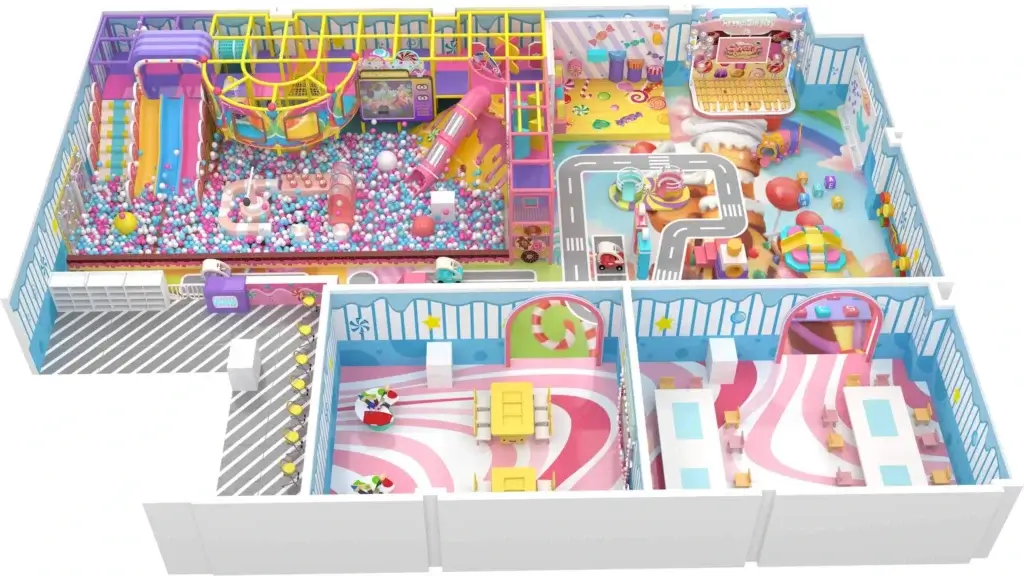Launching a professional indoor playground represents an exciting venture. This business model captivates not just families seeking enjoyable and secure activities for their children, but also attracts day camps, holiday programs, corporate groups, and educational institutions looking to organize outings that blend entertainment with learning.
Nevertheless, achieving success in this industry demands more than simply having an innovative concept and enthusiasm for recreational activities. It calls for thorough planning, strategic financial decisions, and meticulous attention to all operational elements. Every phase—from conducting market analysis and designing the facility to addressing legal and administrative requirements—contributes fundamentally to the prosperity of your professional playground establishment.
Whether you’re new to the industry or looking to expand into indoor entertainment, this guide will walk you through how to open an indoor playground business step-by-step and includes aspects of market research, budgeting, design and maintenance.
What is an indoor playground business?
An indoor playground establishment operates as a specialized recreational facility providing children with protected environments for active play, climbing, and discovery—completely independent of outdoor conditions. Typical amenities include soft play installations, ball pools, vertical climbing surfaces, challenge courses, and imaginatively designed play zones. Many locations further enhance their offerings with supplementary services such as birthday celebration packages, educational workshops, and comfortable lounge areas where parents can relax.
Operating a thriving indoor playground involves considerations beyond simply providing entertaining apparatus. True success hinges on strategic operational planning, strict adherence to safety protocols, and the implementation of specialized management systems that automate reservation processes, digital waivers, membership programs, and operational analytics.
Why open a professional indoor playground?
The indoor playground industry presents a compelling business opportunity driven by strong market demand and meaningful social impact. As urban environments continue to grow with limited outdoor spaces, families are increasingly seeking safe, engaging alternatives for their children’s recreation. This demand is particularly evident in developing municipalities and urban peripheries where dedicated leisure facilities remain scarce. Indoor playgrounds effectively address this gap while providing reliable entertainment regardless of weather conditions, ensuring year-round operation.
The growing awareness of childhood health and development further fuels this demand. With childhood obesity rates having tripled since the 1970s and the American Heart Association identifying obesity as parents’ primary concern, indoor playgrounds offer an ideal solution. They transform essential physical activity into enjoyable play, helping children burn calories while developing crucial cognitive skills and social connections. Additionally, these facilities provide a much-needed alternative to excessive screen time, with the average American child spending five to eight hours daily in front of screens—a habit linked to sleep disorders, attention issues, and reduced physical activity.
From a business perspective, indoor playgrounds offer exceptional financial potential through diversified revenue streams:
- Core admission fees provide baseline income
- Private event rentals for birthdays and celebrations generate significant additional revenue
- Catering services including snacks and beverages increase per-visitor spending
- Educational workshops and themed programs build customer loyalty
Subscription models and multi-visit passes ensure predictable recurring revenue
The competitive advantages extend beyond direct financial returns. Indoor playgrounds serve as powerful customer attraction tools, particularly for young families seeking venues that cater to both children and parents. They create memorable experiences that encourage repeat visits and foster strong brand loyalty. For existing establishments—whether restaurants, shopping malls, or community centers—adding a playground provides a distinct competitive edge, transforming standard venues into family destinations that demonstrate genuine commitment to customer experience.
Moreover, professionally operated indoor playgrounds evolve into valuable community assets. They provide crucial spaces for children’s development while serving as social hubs for parents and caregivers, strengthening community bonds and local identity. This dual benefit of business profitability and social contribution makes indoor playgrounds not just a wise financial investment, but a meaningful addition to any community looking to support healthier, more connected families.
With Guangdong Dream Catch Recreation Equipment Co., Ltd.‘s expertise in creating customized solutions for any space and budget, there has never been a better time to explore this rewarding business venture.
Who Should Start an Indoor Playground Business?
For operators of existing or planned family-oriented restaurants, entertainment centers, museums, or retail establishments, integrating indoor play attractions effectively meets the growing demand among families for wholesome entertainment and convenience—ultimately supporting business expansion. Our solutions at Guangdong Dream Catch Recreation Equipment Co., Ltd. are scalable to accommodate various spatial constraints and financial parameters.
An inviting and well-designed play space motivates families to extend their visits, enhancing their engagement with shopping, dining, and social experiences. Incorporating indoor playground equipment presents a valuable opportunity for businesses such as:
- Store
- Church
- Museum
- Restaurant
- Family entertainment center(FEC)
- Trampoline park
Any amusement area that you want to make kid-friendly
When kids are happy, parents are happy too. A playground helps keep customers relaxed and content no matter where they are.
How to open an indoor playground business: a step by step guide
Step 1. Conduct Comprehensive Market Research
Before breaking ground on your envisioned playground, dedicate time to thoroughly investigate your local market. Critical aspects to examine encompass:
- Demographics: Determine the primary demographic for your indoor playground, covering age ranges, income brackets, and family profiles. Analyze community population data to define your potential clientele. For instance, is there a substantial concentration of families in the vicinity? Which specific age segments are you aiming to serve?
- Competition: Evaluate existing indoor playgrounds and family entertainment venues in the region, comparing their amenities, price points, customer feedback, and operational advantages and shortcomings. This analysis will reveal avenues for distinguishing your enterprise. How can your business stand apart from incumbent competitors?
- Market Trends: Investigate prevailing trends within the indoor play and family entertainment sector to grasp evolving consumer expectations. Are families showing preference for themed environments, sensory-inclusive zones, subscription models, or enhanced party offerings?
Leverage these insights to substantiate your concept and fine-tune your indoor playground business strategy.
Step 2. Develop a Detailed Business Plan
With research in hand, proceed to construct a comprehensive business plan that clearly outlines the playground’s concept, vision, target audience, and distinctive advantages. Essential components should incorporate:
- Company Profile: Explain your operational framework, the style of indoor playground, and the intended customer experience.
- Market Evaluation: Summarize research outcomes related to target demographics, competitive conditions, and industry tendencies.
- Marketing and Sales Approach: Define promotional initiatives for customer acquisition, spanning digital outreach, community collaborations, and event programming.
- Service Portfolio: Itemize the services and attractions available, such as play installations, party options, and food and beverage provisions.
- Operational Strategy: Describe daily workflows, personnel needs, and safety management procedures.
- Financial Forecasts: Present anticipated income, expenditures, and cash flow for initial years, plus funding origins and expected ROI.
- Risk Evaluation: Recognize possible operational and market hazards, accompanied by preventative measures.
- Project Schedule: Develop a phased timeline covering site selection, construction, and grand opening.
- Sustainability and Scalability: Describe approaches for maintaining engagement, ensuring repeat business, and pursuing future growth.
A methodically prepared business plan establishes a solid groundwork for your indoor playground’s prosperity.
Step 3. Select an Optimal Location
The success of your indoor playground heavily depends on its site. Emphasize the following:
- Accessibility and Visibility: Opt for a site that is convenient for your target market, ideally situated in a prominent, high-footfall district to capture spontaneous visits.
- Nearness to Residential Zones and Schools: Locations close to neighborhoods or educational institutions draw more families, simplifying visits for playdates and events.
- Scale and Configuration: Most indoor playgrounds require between 5,000 and 20,000+ square feet, accommodating play sections, seating, facilities, and party spaces.
- Parking Availability: Sufficient, convenient parking is critical for families with strollers and young children.
- Zoning and Safety Conformity: Confirm the site meets local safety and zoning rules for indoor recreation. Engage with municipal offices to clarify stipulations.
- Adjacent Amenities: Proximity to eateries, cafes, and shops can draw additional visitors and improve the overall guest experience.
- Franchise Endorsement (if relevant): Certain franchises provide location support and require lease approval.
- Expense and Lease Conditions: Scrutinize all location-related costs—rent, utilities, refurbishment—and secure lease terms consistent with long-term objectives.
Step 4. Secure Required Permits and Licenses
Launching an indoor playground entails acquiring multiple permits and licenses to align with municipal rules and safety codes. Prerequisites differ by region, but commonly include:
- Business License: A standard operating license from your city or county administration.
- Zoning Permit: Confirmation that the property is lawfully zoned for recreational use.
- Building Permit: Mandatory for any structural updates or interior modifications, verifying construction integrity.
- Health and Safety Permits: Required particularly if serving food, covering sanitation, food handling, and water safety.
- Fire Safety Permit: Ensures the facility adheres to fire prevention and emergency protocols.
- Occupancy Permit: Certifies the space is safe for public use according to capacity limits.
Initiating the permitting process early is advisable, as approvals may take time. Consider consulting a business attorney or advisor familiar with local regulations to facilitate this stage.
Step 5. Select Equipment and Suppliers
Outfitting your venue involves sourcing several key elements:
- Indoor Playground and Soft Play Equipment: Play structures may incorporate climbing components, slides, ball pits, tunnels, and other indoor-safe attractions. Soft play vendors supply padded elements—foam shapes, mats, and interactive features—to combine safety with creative play. Ensure variety to suit different ages and interests.
- Furniture and Seating: Furnish parent lounges, café sections, and party rooms with comfortable, durable seating.
- Safety Flooring: Install impact-absorbing surfaces such as rubber tiles or poured-in-place flooring to reduce injury risks.
- Party Supplies and Decor: Stock themed decorative items—balloons, tableware, and accessories—for birthdays and special events.
- Cleaning and Sanitization Products: Uphold strict hygiene by using approved cleaners and following equipment care guidelines from manufacturers.
Step 6. Implement Supporting Software
Adopting the right technology elevates operational efficiency, guest satisfaction, and revenue potential. Strategic digital tools enable smoother visits and reduce administrative load.
Key software solutions to consider:
- Online Booking and Ticketing: A mobile-friendly system lets guests reserve tickets, memberships, and party bundles online, shortening lines and increasing prepaid sales.
- Digital Waivers: Allow waiver completion before visits to expedite check-in and improve safety compliance.
- Self-Service Kiosks: Speed up entry and F&B orders, allowing staff to concentrate on service and supplemental sales.
- Mobile Food and Drink Ordering: Empower guests to order via smartphones, minimizing wait times and raising average spend.
- Automated Feedback Collection: Use post-visit surveys to gain insights, improve services, and strengthen guest relationships.
How much does it cost to start an indoor playground?
Opening an indoor playground presents a rewarding business opportunity, though it demands substantial initial capital investment. On average, startup expenses fall between $40,000 and $700,000. The final amount will be significantly influenced by variables such as your geographic location, facility scale, equipment selection, staffing requirements, and the overall scale and complexity of your attractions and services.
For most indoor playground operators, the most substantial expenditure involves securing and preparing an appropriate space. A standard facility generally requires 5,000 to 20,000 square feet or more, depending on your target market and operational approach. Associated costs include:
- Leasing or purchasing a property suitable for family-oriented entertainment
- Renovation and construction outlays, including flooring, safety surfaces, climate control systems, lighting, and fire safety installations
Zoning approvals, permits, and licensing fees, which vary by jurisdiction and project scale
In high-density urban settings, lease rates tend to be elevated, though the potential for consistent walk-in traffic is greater. In suburban or rural locales, rental costs are typically lower, but operators often need to allocate more resources toward marketing efforts to build awareness and draw visitors.
Additional significant expenses encompass:
- Indoor playground apparatus (slides, climbing structures, dedicated toddler zones, obstacle courses)
- Technology infrastructure and management systems (handling reservations, point-of-sale, digital waivers, membership programs, and analytics)
- Insurance coverage and legal fees (including general liability and property insurance)
- Staff recruitment, compensation, and training programs
- Marketing and branding investments for your business launch
- Funding options for your indoor playground
Success lies in thorough preparation
Launching an indoor playground represents an exciting venture—and with proper planning, it can grow into both a profitable and personally fulfilling enterprise. Keep your guests’ needs at the forefront, emphasize safety and enjoyment, and implement systems that enhance operational efficiency rather than increasing workload.





